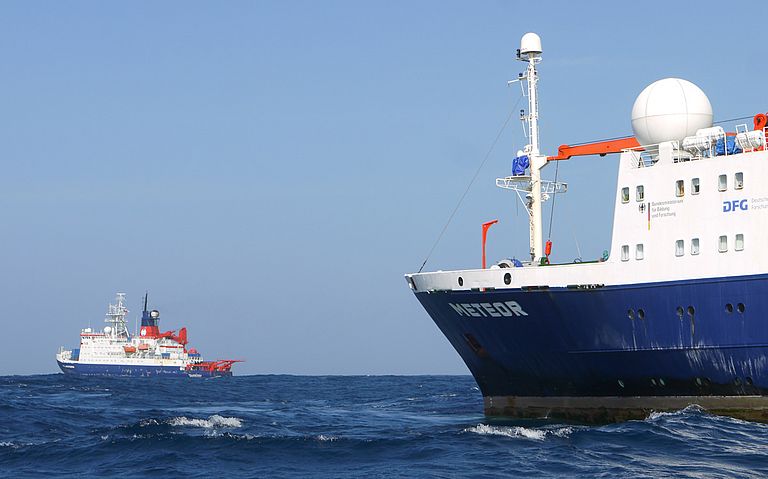Summit on the High Seas
German research vessels POLARSTERN and METEOR meet in the tropical Atlantic
This was not a scheduled meeting. It came about through the casual contact between scientists and crew on both ships. Once it became clear that the POLARSTERN would cross the research area of METEOR, the two expedition leaders, Prof. Dr. Martin Visbeck from GEOMAR Helmholtz Centre for Ocean Research Kiel and Dr. Hartwig Deneke from the Leibniz Institute for Tropospheric Research, agreed on a date and location for such a summit meeting.
At about lunchtime on March 23, the inflatables on both, METEOR and POLARSTERN, were readied, and brisk shuttle traffic commenced between the ships at temperatures around 23°C. The visits were used to share some of the results on both research cruises. Of course, there was also great interest in visiting with the respective colleagues and their research equipment. Many of the cruise participants did not know the other research vessel and were curious about the work and research opportunities on board. Others were happy to revisit the familiar colleagues and acquaintances from previous trips.
After a short four hours, it was time to conclude the mutual visits. It was a nice and interesting interruption of the day-to-day research activities for all. METEOR continued to sail further south on her measurement campaign, while POLARSTERN continued on a northerly course. After a port call in Las Palmas, POLARSTERN is expected back in Germany in April.
POLARSTERN, on her way from Cape Town to Bremerhaven, is completing a long and successful season, including wintering in the Antarctic. The research consisted of a major scientific program, measuring exchange processes between the atmosphere and the ocean in the context of the OCEANET program, with most of it done from a moving vessel. At the same time, living organisms from the Antarctic are transported to the Alfred Wegener Institute, and birds and marine mammals were observed along the ship's route.
METEOR just began a surveying trip in the area between 8°N to 12°N and 25°W to 19°W. Eighteen months ago, Visbeck and his colleagues had injected a marker substance, or tracer, in 350 meters water depth. Its distribution is measured over the next three weeks, thereby allowing conclusions on the currents and mixing near the vast oxygen minimum zone in the region. Furthermore, many different biological and chemical measurements are taken that contribute to a better understanding of the nitrogen and oxygen circulation in the ocean and how they vary under the influence of climate change.
Contact:
Dr. Andreas Villwock (GEOMAR, Communication & Media),
Phone: +49-431 600-2802, avillwock(at)geomar.de




